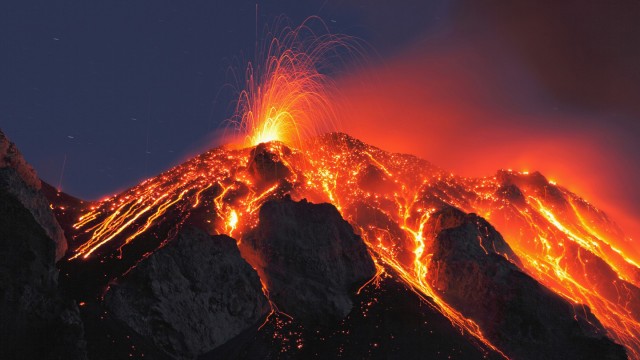volcanoes
A VOLCANO IS ANY vent on the surface of the Earth, or another world, which allows molten rock, ash, steam, gas, or pyroclastic debris to spill out. Volcanoes proliferate along the edges of the Earth's tectonic plates, and are found on other satellites in our solar system, such as Io, one of Jupiter's moons. In a volcano, a tunnel or conduit allows magma from below the Earth's surface to flow upward to the vent, where it may erupt in the form of flowing lava, flying projectiles, or clouds of steam, gas, and ash (fragmented lava). The vents occur under water or on land. Lava flowing under water cools and often forms “pillows” of basaltic rock several meters in diameter. On land, a cone can build up around a vent; the cone is formed of the ash and lava that erupts and then cools. A caldera is created at the top of a volcano when an explosion causes the roof of a magma chamber to collapse upon itself and cool. This forms a depression. Crater Lake in OREGON is an example of a freshwater lake lying in the huge caldera of an inactive volcano.

There are many ways to classify volcanoes, but none cover all the variations. Morphologically, 90 percent of all volcanoes fall into six categories. First, over 60 percent of volcanoes are strato volcanoes, or composite volcanoes. These are often steep mountains formed by viscous lava flows of andesite and dacite. Strato volcanoes are explosive, and about half the product expelled from them is pyroclastic material, the other half lava. Mount St. Helen's in WASHINGTON State, Mount Fuji in JAPAN, and Mount Pinatubo in the PHILIPPINES are famous examples of these.
Shield volcanoes, such as Kilauea and Mauna Loa in HAWAII, are made of the basalt formed from fluid lava flows. They are large, less explosive, and not as steep as strato volcanoes. A third type is the rhyolite caldera complex, the most explosive. Rhyolite caldera complexes don't look like volcanoes; they self-destruct during their eruptions and usually leave nothing but a crater or caldera and debris behind. The last eruption of this type was Taupo, NEW ZEALAND, in 83 C.E.
Another form of volcano, the monogenetic field, is caused by a low supply of magma. No mountain or cone builds up from the vent of this volcano, and new eruptions often form new vents. MEXICO has several monogenetic fields. Flood basalt volcanoes consist of basalt lava flows up to 40 mi (50 km) thick and hundreds of miles long, in which slow-moving lava builds up the flow. The Columbia River basalt province in the northwest United States is an example of this. The last common type of volcano is the mid-ocean ridge, a submarine volcano that occurs along the oceanic plates. In fact, the mid-ocean ridge builds those plates, by expelling lava between two plates.
into two types: fissure and central. Fissure volcanoes occur along fractures in the Earth's crust and eject basaltic lava; they are rarely explosive. Central volcanoes develop into cones, with a central vent guiding magma upward.
Volcanoes have been responsible for incredible devastation. In 1815, Tambora Mountain on the Indonesian island of Sumbawa erupted for 10 days and killed 56,000 people. The explosion was heard and felt 1,000 mi (1,609 km) away. Besides the 12,000 killed by the blast itself, 44,000 people on the island of Tombock, 100 mi (160 km) distant, died of starvation when all vegetation and animal life was extinguished by being buried in ash. Although Tambora was not quite as powerful as the more famous 1883 Krakatau eruption, it is estimated that Tambora ejected 20 times more debris into the air. The world temperature was affected for three years; frost covered the southern UNITED STATES on the Fourth of July that year. The year 1816 was called a year without summer, and crop failures resulted in food shortages in Europe and North America through 1819.
Besides the immediate threat to human, animal, and plant life, volcanic eruptions are a major source of air pollution, and some research links volcanic eruptions with EL NINO events and other global climatic effects. The gas most commonly expelled by a volcano is steam; water is contained in the magma that pushes up from below the surface. Some volcanologists believe that all new water on Earth comes from volcanoes. By volume, carbon dioxide is the second most common gas from volcanoes.
The 1982 eruption of the El Chichon volcano in the state of Chiapas, Mexico, released 30 million metric tons of carbon dioxide, a greenhouse gas, into the atmosphere. Since carbon dioxide is heavier than air, it can collect in low clouds and kill many people and animals during eruptions. Sulfur dioxide, a component of acid rain, is the third most common gas resulting from a volcano and contributes to global cooling for several years after a large eruption. Between 1980 and 1988, Mount St. Helen's emitted about 2 million tons of sulfur dioxide—half of this in the major eruption of May 18, 1980.
Volcanoes exist on other worlds as well. Domes, cones, basalt plains, and other volcanic features have been identified on the moon, although the volcanic activity that produced these occurred 3 to 4 billion years ago. Mars has shield volcanoes larger than Earth's, but the volcanoes have not been active for over a billion years. Thousands of volcanoes dot Venus; whether they are active is not known. None of these worlds show evidence of plate tectonics, which is closely associated to volcanoes on Earth. By far the most interesting spot in the solar system for volcanologists is Io, a moon of Jupiter, where 356 calderas were identified by the Voyager and Galileo spacecraft in 1979 and 1995. Earth-based telescopes and satellites now monitor the volcanic activity on Io.